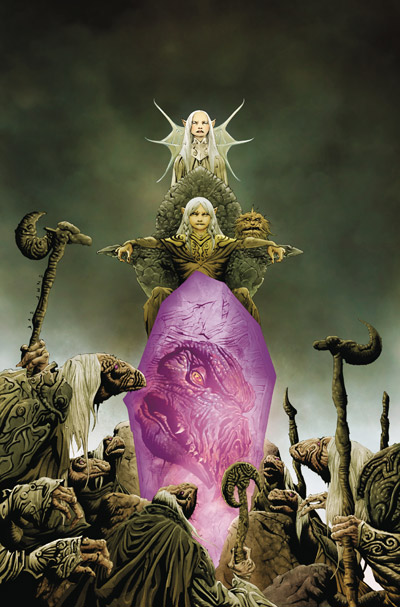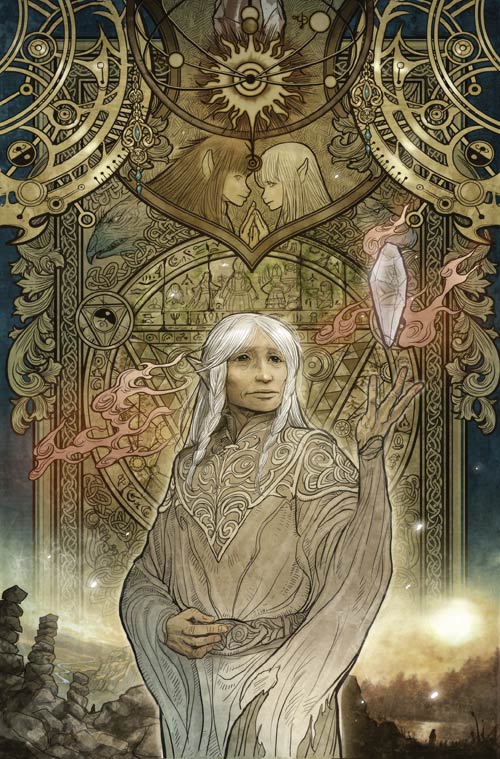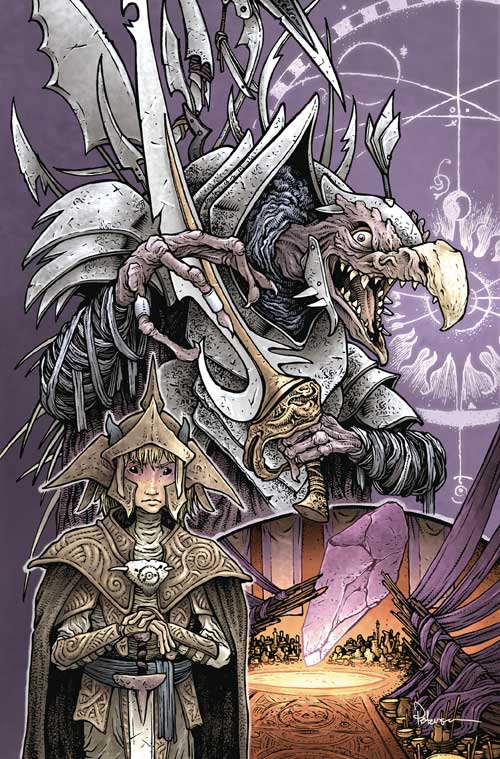Bright Lights Behind The Dark Crystal
Dec 16, 2016
 |
It was a groundbreaking movie to say the least. In cinema history, it's not a stretch to say that The Dark Crystal was a groundbreaking film that showcased the best puppetry that was ever put on film. That's no slight to the story, either, which is why BOOM! Studios vigorously pursed the idea of a sequel. And now that has come to fruition! In this interview with Simon Spurrier and Kelly & Nichole Matthews, BOOM! Studios examines how these creators approached working on the new maxi-series Jim Henson's The Power of The Dark Crystal, which will be heading to comic shops February 2017!
**********
BOOM Studios: You’re adapting the sequel to The Dark Crystal into a comic book series. What does it mean to you to take on something like this?
Kelly & Nichole Matthews: To be honest, it’s a little intimidating! The Henson Company has created so many cherished stories and characters, and The Dark Crystal itself was a fantastic film. It’s some big shoes to fill, creatively speaking, but it’s also incredibly exciting. To be able to dive back into the world of Thra, to bring life to its inhabitants again and share their new stories; that’s an amazing opportunity. We want to bring our best for this, and really do it justice.
Simon Spurrier: It’s huge. It’s a glorious direct nerd-line between Si the comic book writer and Si the bright-eyed fan.
There aren’t too many licensed gigs out there which I’m literally incapable of refusing. Dark Crystal’s one of them.
I get it: Some people will arch an eyebrow at my weird affection for an old cult movie about puppets, monsters, and aristocratic lizard-vultures. But I softly insist there’s a lot more going on beneath the Weird-fi surface of that movie—in fact, a lot of very elegant and clever stuff—and I’m dialling that up in the sequel.
Here’s the thing. A lot of fantasy stories, especially in our post-Tolkien world, feel the need to bombard us with intricate histories, Machiavellian politics, copious family trees, cultural ontologies, blah blah blah. It’s as if they’re faintly embarrassed by their own unrealness, and need to overcompensate with a bunch of very grown-up detail.
For me, The Dark Crystal is the purest expression of imagination-led fantasy. It doesn’t care about being a grown-up. It cares about extraordinary places and wondrous creatures. It cares about love and learning and doing the right thing. It cares about trees with tentacles, rocks that sing, girls made of fire and gemstone bats.
The primary joy, in fantasies like this, is to leave your earthly adulthood at the door and go on an adventure somewhere beyond your dreams. That’s a note I’m determined to strike with this comic.
BOOM Studios: What is the origin of your Dark Crystal fandom? What do you like about the film?
Simon Spurrier: There’s an element of nostalgia here, I can’t deny it. I’m an ’80s kid, after all. That movie occupies a really important niche in my story-life, being the first live-action flick I saw with literally no human characters. And yet it oozes more humanity than most normal stories. That’s a pretty big deal. And hey, it’s kinda scary too, especially for a little kid, and yet the sheer immersive joy of spending 90 minutes in a whole new world somehow made that okay.
But it’s not just nostalgia, and that’s what I’m keen to demonstrate with this sequel.
In simple terms, that movie is a profoundly clever take on childhood. We the viewers—just like the two heroes, Jen and Kira—are being invited to wander through a world where literally everything we see is new and wondrous. As adults, that’s not an experience we get offered very often.
Even more clever: having been ushered into a story with a fundamentally childish POV, we find that literally every character in the film is a child, dressed-up as something weirder. From the wide-eyed innocence of the Gelflings to the sulky, bullying Skeksis; from the fun-loving playtime of the Podling villages to the lazy, window-staring dreamers of the Mystics. These are archetypes you’ll find in every classroom the world over.
The one exception is the character Aughra, who plays the role of the adult in the room. In story terms her function is to pop up occasionally and tell us, “Don’t worry, you’ll understand when you’re older…” so that the adventure can continue. It’s a very clever trick in a very clever fantasy, all disguised as something exceedingly simple.
For me the genius of The Dark Crystal—even beyond the practical-effect puppetry (which still feels more convincing than the most bleeding-edge modern CGI)—is that the story revolves around the very thing the audience is feeling: wonder.
Needless to say, wonder sits at the very heart of the comic, too.
Kelly & Nichole Matthews: We grew up watching every Henson film our mother could get her hands on. She loves the Muppets and has seen everything the Henson Company has ever put out. We’d watch “The Muppet Movie” and sing along to all the songs; it was great! There’s something magical about Henson films, especially when you’re a child, and that magic sticks with you even when you get older.
The Dark Crystal itself was an experience. The style, the atmosphere, the aesthetic of it really stuck with us when we went on to create our own stories growing up. We love putting a lot of gothic fantasy and old, spindly flora into our art, and we think that’s a direct result of The Dark Crystal’s influence, among others.
BOOM Studios: How does your original work inform what you’re doing with The Power Of The Dark Crystal?
Simon Spurrier: It’s sort of the other way around, strangely enough. I can draw a direct line between the original movie and a great deal of my creator-owned work in comics. Things like The Spire wouldn’t exist without The Dark Crystal as a mental reference. It’s that lovely liberty to acknowledge that “fantasy” doesn’t have to mean orcs and knights and bloody dragons.
Pretty much everything I’ve ever written cheerfully thumbs its nose at the idea of genre conventions, and I don’t think I’d have such a bloody-minded approach to the Wondrously Odd without TDC in my past.
Telling stories in this world and with these characters feels like a lovely homecoming.
Kelly & Nichole Matthews: This story feels like one of those things you worked up to your whole life without realizing it. In our personal projects, we tend to go for epic landscapes and fantastical elements. Something you’d see in an animated film. We try to make everything meaningful and flesh out the world and characters even without dialogue present. Even from our early, amateur works to our first professional gig with Archaia, Toil and Trouble, it felt like it was laying the foundation that led us to this.
BOOM Studios: Relative to the original The Dark Crystal, when is this set? Which characters from the first film are in this series?
Simon Spurrier: It takes place a long time after events in the original story. A century or more. The world, Thra, has changed radically. New life, new wonders, new horrors.
As before, we see it all through the eyes of an innocent, to whom it’s just as new and magical—and frightening—as it is for us. Her name is Thurma… she’s a girl made of fire.
The heroes from the first story are still alive, and they’ve spent decades turning Thra into a Gelfling paradise, using the Crystal’s light. But Jen and Kira are now extremely old, spending much of their time adrift in dreams, and in their absence sly hints of darkness are creeping once more into the civilization they’ve built...
Thurma blunders into this powder-keg scenario with a desperate quest of her own. She knows there’s another world, deep underground, on the verge of destruction. To save it she must steal a shard of the crystal.
But that would mean cracking it... splitting the light in two... and unleashing the vile Skeksis once more.
BOOM Studios: Why do you think comics is a great way to tell this story?
Simon Spurrier: By way of a quick history lesson: This series is based loosely on a screenplay which has been in development on and off for years. That script has passed through various writers’ hands, and in its final form it’s packed with great ideas and a really powerful central thread. It’d make a great movie, no doubt about it, buuuut...
...oh boy, as the basis for a comic? It’s a delight. We can use the form to expand, elaborate, enhance, and inject fresh beauty into the whole thing. Most of the changes I’ve made have been purely additive, but where I have tweaked more determinedly it’s been solely to make the most of the unique possibilities comics give us in terms of perspective, pace, and scale.
I mentioned up top how much of my fascination for this world revolves around sheer, unbridled wonder. I truly believe we can do things with comics which mine that vein deeper than any other medium.
Kelly & Nichole Matthews: In any scenario where you can tell a story in a film, you can also do it in a comic format. In a comic, the only limits are your imagination and drive, and the way you use them can push a story even farther than what you could on film.
 |
 |




